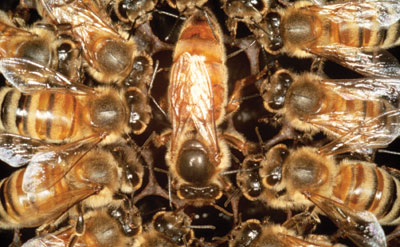“Ego expands to fill the space not filled by knowledge.”
– Jeffrey Armstrong
“Ego expands to fill the space not filled by knowledge.”
– Jeffrey Armstrong
Once upon a time there was a queen bee.
She enjoyed talking to her beekeeper, who, fortunately enough, enjoyed listening to her. She was fortunate, that is, because the beekeeper considered himself a poor conversationalist, and so was happy not to have to share the burden of finding interesting topics to talk about.

And besides, there are lots of talking beekeepers around, but not so many talking bees, so he figured he’d take advantage of the opportunity while it lasted.
The beekeeper was in this way wise, but he wasn’t very bright. The evidence: The queen’s favorite topic was the land of milk and honey, and how she was going to lead the beekeeper there.
Finally the day came when the beekeeper couldn’t stand it anymore. “Let’s go!” he said to the queen, flushed with the enthusiasm that comes from a vision of a better tomorrow. “I don’t want to wait another day!”
So off they went to find the land of milk and honey.
Leaving behind a hive full of honey. And full of the worker bees who made the honey. Also all of the ingredients needed to make a new queen for the hive.
The moral of the story is, don’t be a queen bee CIO.
I ran across one of these characters not all that long ago. I had four one-hour conversations with him over the span of a couple of months. He was a visionary, talking in glowing terms about how the brilliant information technology he’d recently brought in and the new and even more brilliant information technology he was going to bring in soon that would transform the company.
Remarkably, in all of the time we spent together he never once mentioned anything about the department he “led,” what his plans for it were, where it needed to improve, or where it already excelled.
Unremarkably, nobody in the entire IT department could make a decision of any kind, with the possible exception of where to have lunch.
What causes an IT manager to become a queen bee? That’s for psychologists to diagnose, not workaday IT commentators. Or perhaps for budding ethologists. We could, I suppose, get them together to resurrect the pointless nature vs nurture debate, even though it was long ago resolved.
Bee it nature, nurture, or a combination of the two really doesn’t matter. A queen bee sits at the top of your IT hive, and you have to cope with her. Or him; unlike honey bee queens, both male and female CIOs can wear an apian crown.
So what you do if you report up to a queen bee CIO?
You could feed her/him royal jelly (pushing the metaphor to its limits, this of course means mastering the fine art of sucking up). This can work in the short term … queen bees do love hearing how brilliant they are … but it’s a bad habit to develop. Once this becomes your normal you’ll lose the habit of initiative and decisiveness that help you succeed in healthier environments.
And so you’ll find yourself seeking out queen bees to work for.
No thanks.
Then there’s the obvious solution: Leave. It’s the best general-purpose advice there is no matter which sort of bad manager you report to, because bad managers aren’t going to change — the attitudes and behavior that make them a bad manager are what, in their eyes, got them to where they are today.
So by all means, explore the world of opportunities that surrounds you.
But as you do, consider a different sort of departure.
As has been pointed out in this space from time to time, wise CIOs are starting to encourage what’s commonly called shadow IT — information technology that happens outside IT’s organizational boundaries.
Unwise CIOs still try to stomp it out, but fail.
Therein lies an opening you can exploit.
If there’s one thing you can be certain of, it’s that your corporate beekeepers will soon tire of the queen bee CIO’s tales of milk and honey. They want their milk and honey right now.
And if IT can’t deliver it, well, maybe shadow IT can.
With your help.
You will, of course, need to tread cautiously. But there’s a good chance your company has a director or three who have the budget and don’t care about obeying the IT governance process that’s been stymying them as they try to turn their own visions into business reality.
You know IT. You know the business (you do, don’t you?).
With finesse, you can be the person who actually does make IT happen.
Not a bad place to be when the CEO kicks the queen bee CIO out of the hive.